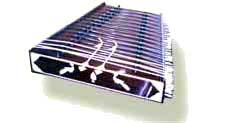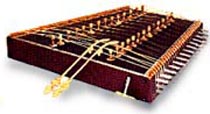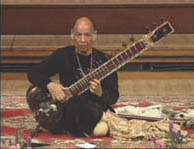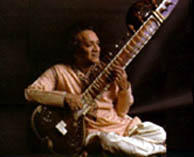The most often heard instruments in Hindustani, or North Indian classical music.
The violin, which is also used in Europe, is not included on this page, although its (non-tempered) structure is perfectly suitable for playing authentic Indian Classical Music based on vocal music. Those instruments, which are rarely heard on stage (eg. jaltarang, dilruba etc.) were also left out of the list, as well as the folk instruments (eg. khung, murchang, dhol etc.), which can be a lot of fun for the traveller of the Indian countryside, who meets musicians on their way. The following instruments are discussed on the site:
bansuri :: harmonium :: pakhawaj :: rudra-vina :: santur :: sarangi :: sarod :: shehnai :: sitar :: surbahar :: tabla :: tanpura
 |
material: bamboo with six or seven holes |
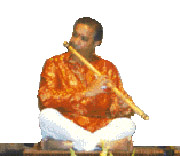 |
Krishna’s favourite instrument. There is reference to the flute in the Vedas (‘transversely blown instrument’). Also, there is a whole chapter on this instrument in the book of Bharata, titled Natyashastra, which was written around the beginning of our era. Thus the bansuri is one of the most ancient Indian instruments. However, the classical musical stages were only conquered by this instrument with the play of the legendary Pannalal Ghosh.
Hariprasad Chaurasia |
 |
3-3 1/4 octave register instrument, which can be played on with a hand operated bellows at the back and with a keyboard of course. |
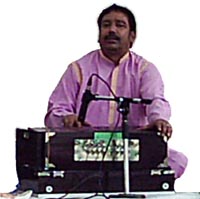 |
Probably it was brought to India from Europe by the Christian missionaries. It couldn’t get established as a solo instrument, even with many modifications (the use of more whistle systems etc.), since being a tempered instrument, it cannot produce one of the basic features of Indian music the meend (the “bending” between two notes). Beside the sarangi it is the accompanying instrument of the khyal vocal performances, and of the qawwali.
Mehmood Dholpuri |
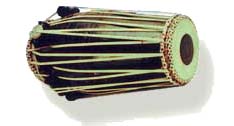 |
The material of the body: sesamewood the leather: camel, goat or deer skin |
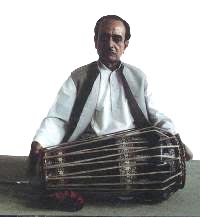 |
Beside the southern mridangam this is one of the oldest rhythmical instrument. Its technique is partially based on the rhythm of reciting of the Vedas. Usually it is the accompaniment of dhrupad (vocal and instrumental) performances, but it can also be heard as a solo instrument. While the tabla is struck with the fingers to make the sound, on the pakhawaj the different parts of the hand (palm, edge of the hand, etc.) are used by the player. According to a legend, a broken pakhawaj gave the idea for the making of the first tabla.
Chartapati Singh |
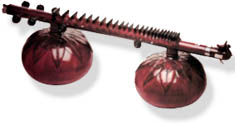 |
It has 8 strings (S P, M, S, P,, S,, P, G,) the material of the body: teak-, or tunwood (an Indian cedar type) the material of the resonators: gourd (similar to the calabash-gourd, but this type of gourd is especially grown to make an instrument) a typical dhrupad instrument |
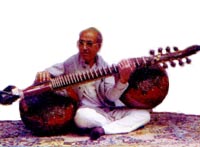 |
In the book of Bharata, titled Natyashastra there is an entire chapter, writing about the vina. An instrument, which can be recognized on many ancient depictions (coins, paintings, statues), and which obtained its present form only a century ago.
Zia Mohiuddin Dagar |
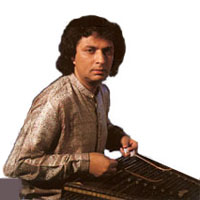 |
Shiv
there are 94 strings altogether, on 31 bridges the material of the body: teakwood |
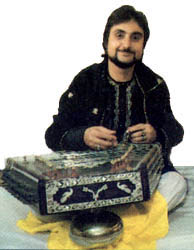 |
Bhajan
there are altogether 123 strings, on 41 bridges |
|
Shiv Kumar Sharma style santur
|
|
Bhajan
Sopori style santur |
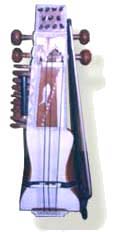 |
It is an instrument which typically resembles the tone of the human voice, for this reason it is often used as a solo instrument, and as the accompaniment of khyal performances.
It has 4 main (S P, S, S) and 36 resonant strings |
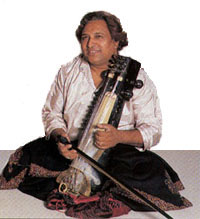 |
The sarangi is played on with a bow. The gut strings give a warm sound, and the great number of resonants ensure the richness of the overtones. It is probably a really ancient instrument, since one of its variants (sarinda, chikara, kamaicha, ravanhattha, etc.) can be found in the music of all the ethnical groups of India.
Sabir Khan |
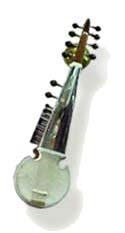 |
There are two basic structures. Ali Akbar Khan style sarod, which has 10 main strings (M S P, S, N, R G S S’ S’) and 15 resonant, and the Amjad Ali Khan style sarod, which has 8 main strings (M S P, S, S S S’ S’) and 12 resonant strings. the material of the body: teak or tunwood the cover of the resonator: leatherIt is played on with a plektrum (a so called java), which is traditionally made of coconut shell, while the player uses his nail on the neck to slide from one note to the other on the strings. |
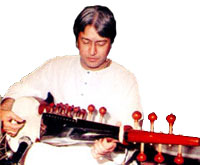 |
The sarod is one of the unequivocally recognizable Indian instruments on the oldest paintings. One hundred years ago metal replaced the wooden one on the neck, thus making the vocal like elements (meend, gamak etc.) easier to produce, while the taraf strings added in the past century, give the richness of the overtone, so typical of Indian instruments.
Amjad Ali Khan |
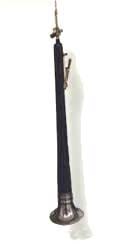 |
A double reed (sometimes quadruple reed) windwood instrument the material of the body: mulberry wood the material of the reed: reed (pala grass) the material of the cone: copper, silver, or maybe gold |
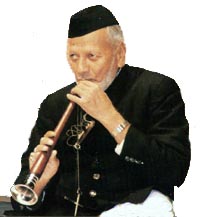 |
It came into consideration as a classical instrument only in the last century. There are two reasons for this. Earlier less meend technique was used on it, thus there was not such a shehnai player, who could make shehnai playing acceptable on classical stages, not to mention that the reed is in connection with the saliva of the player, and since saliva is considered unclean in India, the instrument itself was considered unclean until finally the shehnai playing of Bismillah Khan opened the doors to the classical stage.
Bismillah Khan |
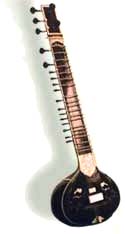 |
Vilayat
It has 6 main (M S, G P S S’) and 12 resonant strings The Vilayat Khan style sitar playing is based on the khyal style. |
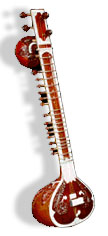 |
Ravi
It has 6 main (M S, P,, S,, S S’) and 12 resonant strings The Ravi Shankar style sitar playing is based on the dhrupad style. |
| The sitar has gone through a lot of changes in the past centuries. The previously three-string instrument (probably its name comes from the Persian sehtara, that is ‘three-strings’) received the chikari, and the set of high-pitched contrastrings (in the case of the Vilayat Khan style sitar P S S’, while in the case of the Ravi Shankar style sitar: S S’), and the taraf (resonant strings) to ensure the tinkling sound. The quality of the baj (the main melody string) enabled the player to produce the vocal techniques. The two main forms of the instrument used today only obtained their present form in the past century. | |
|
Vilayat
Khan style sitar |
|
Ravi
Shankar style sitar |
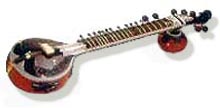 |
It has 7 main (M S, P,, S,, P S S’) and 11-17 resonant strings the material of the body: teakwood or tunwood the material of the resonator: gourd |
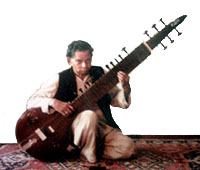 |
It resembles the rudra-vina in its voice and the sitar in its structure. However, it is a lower-pitched instrument (4-12 notes) than the latter one. According to some measurements it can produce sounds even below 20 Hz. The surbahar obtained its present form about a century ago. It is probably an instrument invented by Sahabdad Khan által kitalált, and later further developed by Imdad Khan (the founder Imdad Khani Gharana), the specification of which is that it became an instrument with the tone of the rudra-vina used in the dhrupad style, but still enables playing in the style of khyal. Nowadays the surbahar can be heard as the solo instrument of both the khyal and the dhrupad. Balaram Pathak |
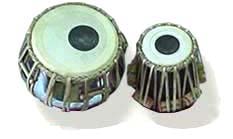 |
the bayan (left -low-pitched- side) made of: redcopper or bronze the dayan (or: tabla, right –high-pitched-side) the material of the body: rosewood the leather: camel, goat or deerskin the material of the shyahi or akh (black eye): a mixture of ash, metal gratings etc. |
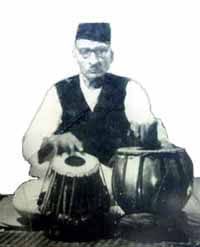 |
The structure of the tabla and the playing style is the result of Muslim influence. Numerous schools are known, but only one of these (the Benares Gharana) originates itself from the ancient pakhawaj playing, where the sounds are produced with the palm, whereas in other schools the virtuoso playing with the fingers is typical. The use of the fingers resulted in the speed of tabla playing, thus enabling the player to play several new bols, or even to play a set of bols typical of his own play.
Ahmad Jaan Tirakwa |
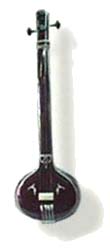 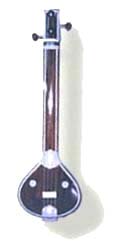 vocal tanpura — – – – instrumental tanpura |
The material of the body: teakwood or tunwood the material of the resonator: gourd or wood The basic instrument of Indian classical music. Although it is only an accompanying instrument, it is a characteristic of all performances. Its function is to play the ragas main notes (drones) continuously. This way, all notes played during the performance will be relative to this whirling of sound. There are types for vocal and instrumental performances. |
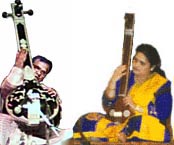 |
An unequivocally recognizable instrument on the ancient paintings, the variants of which are also known outside of India. |
